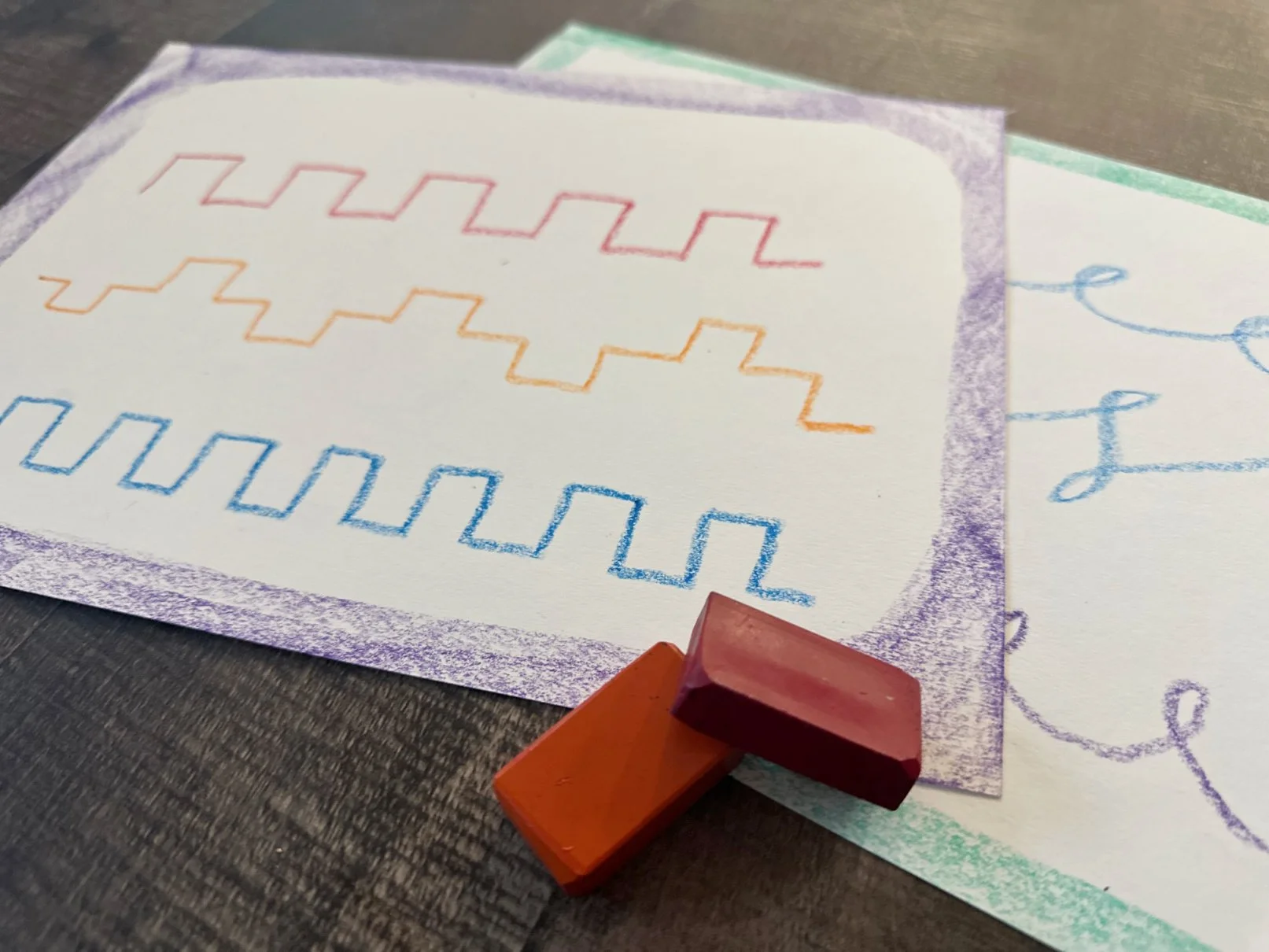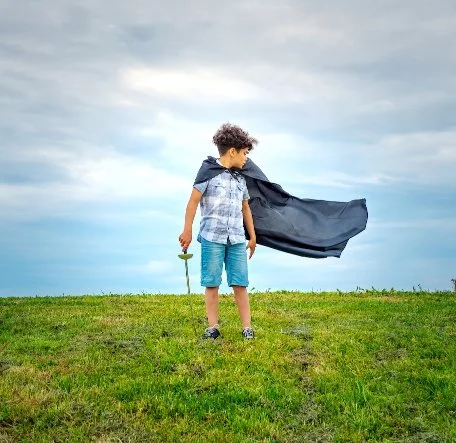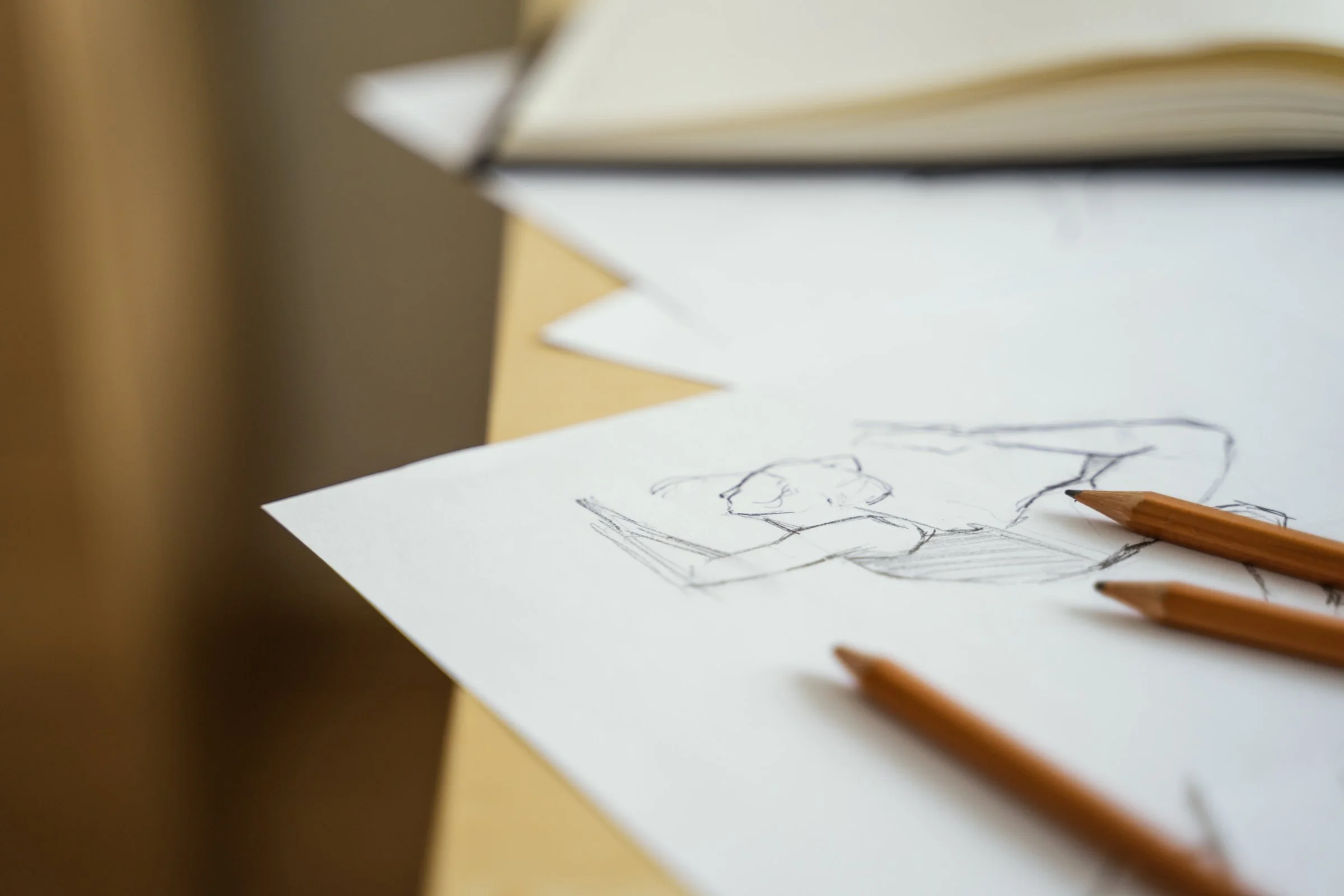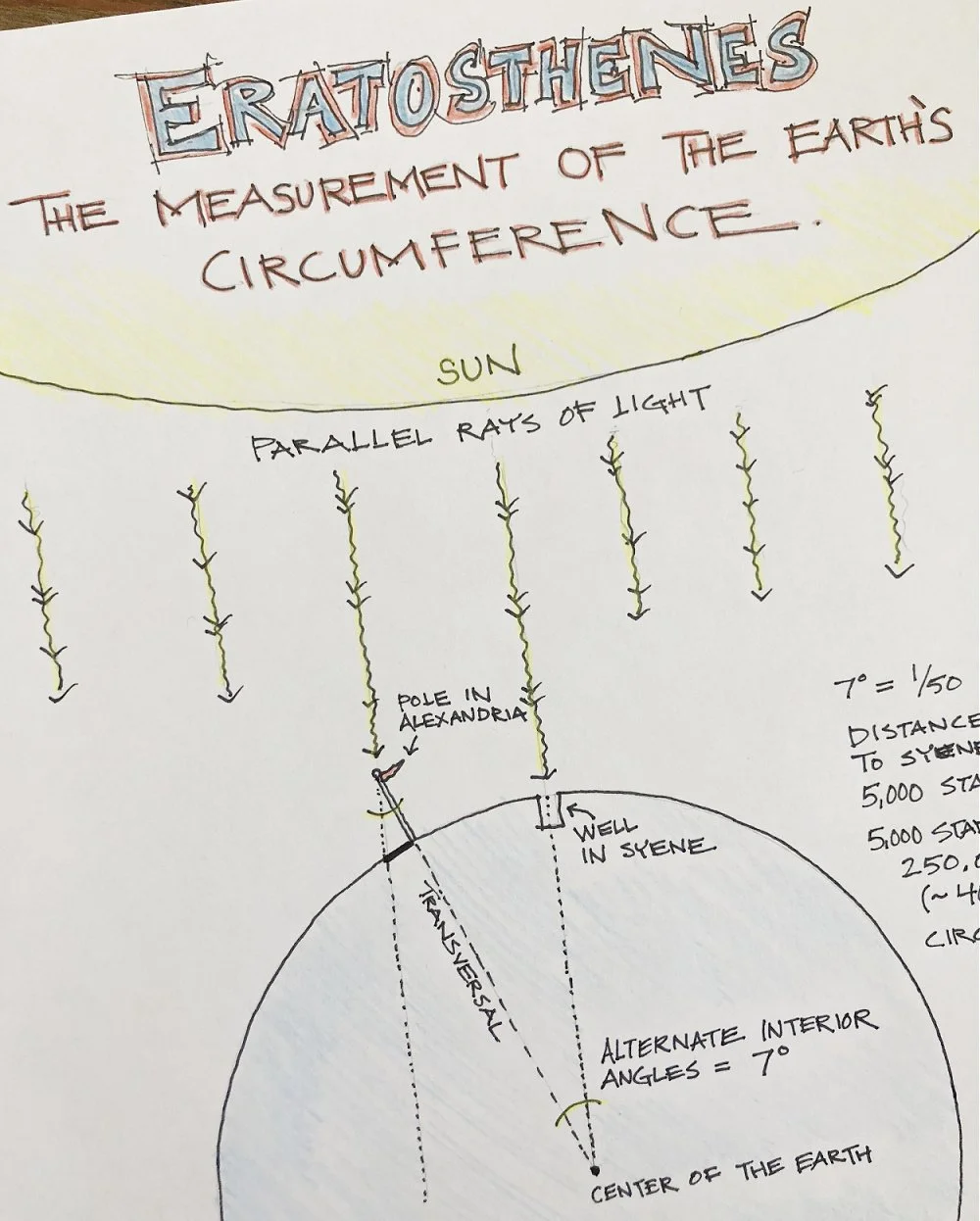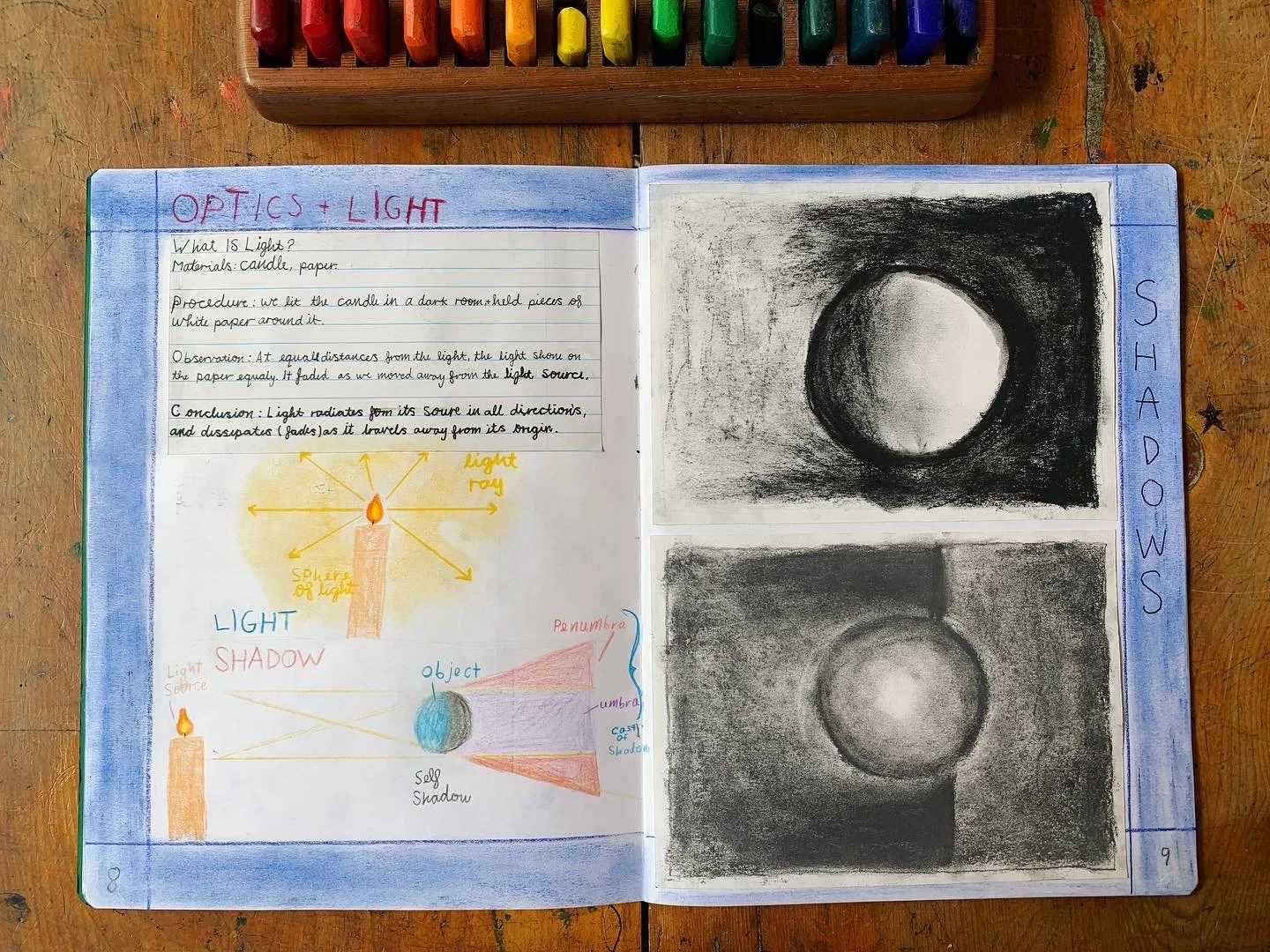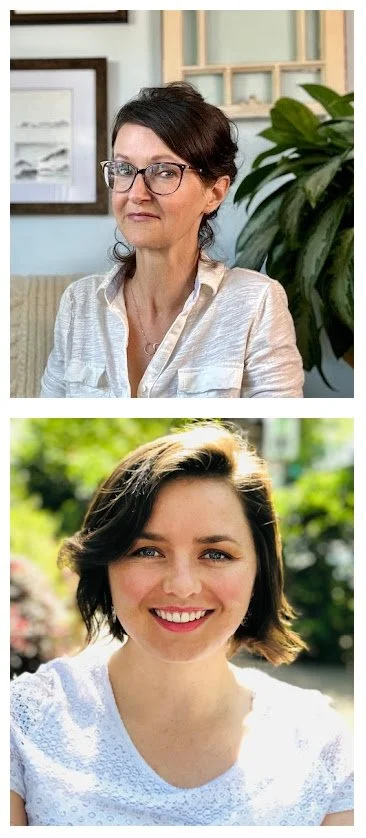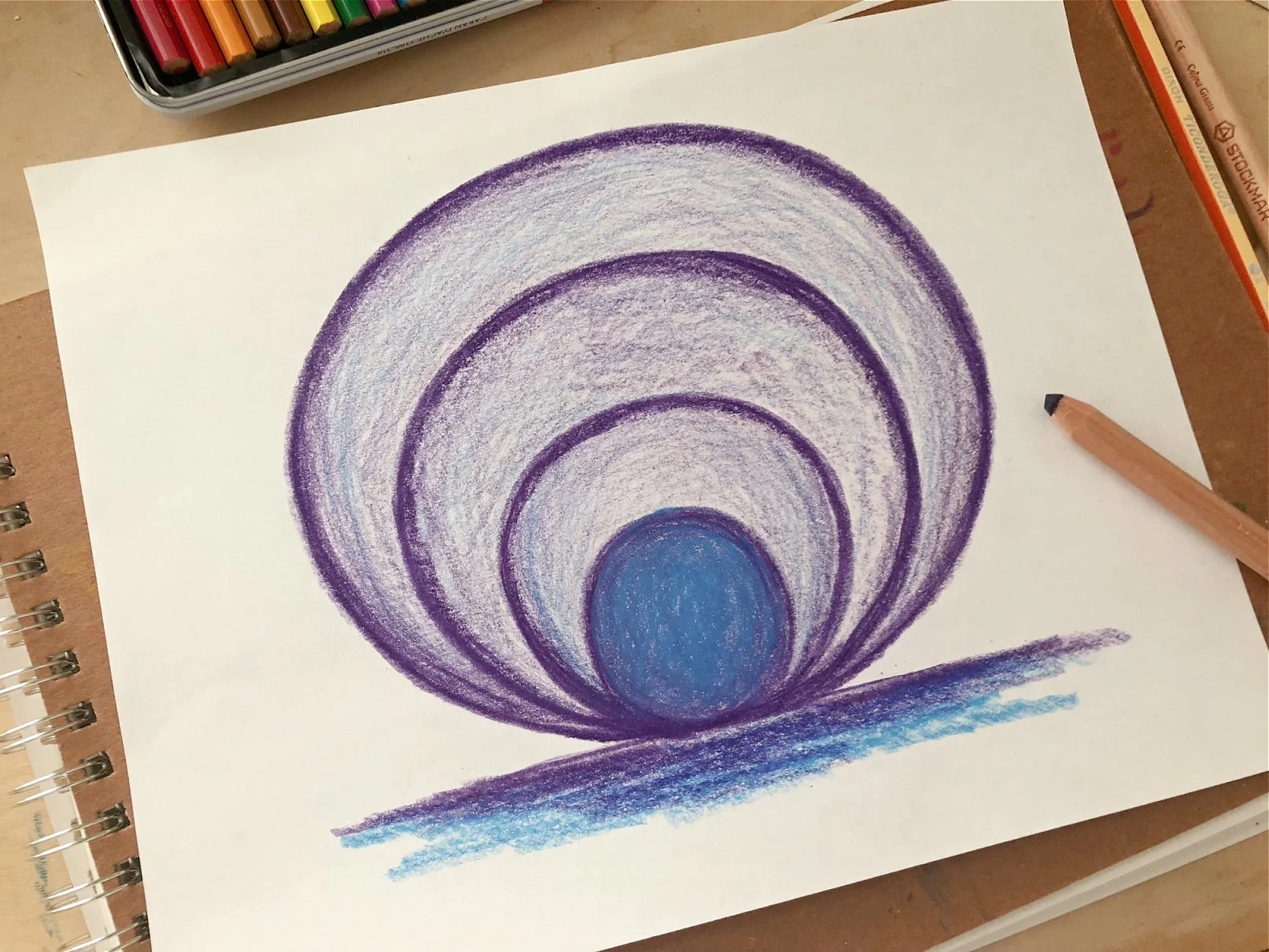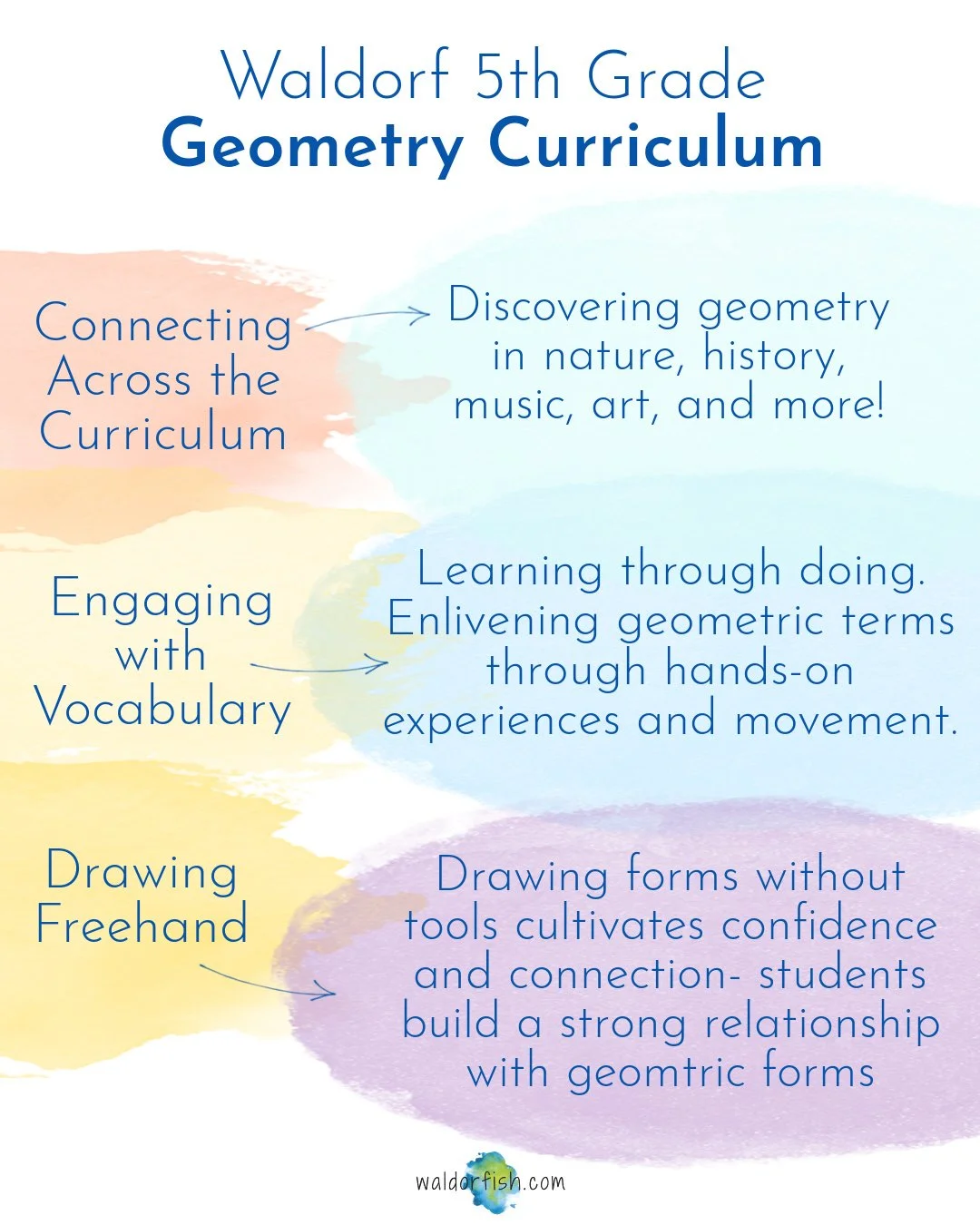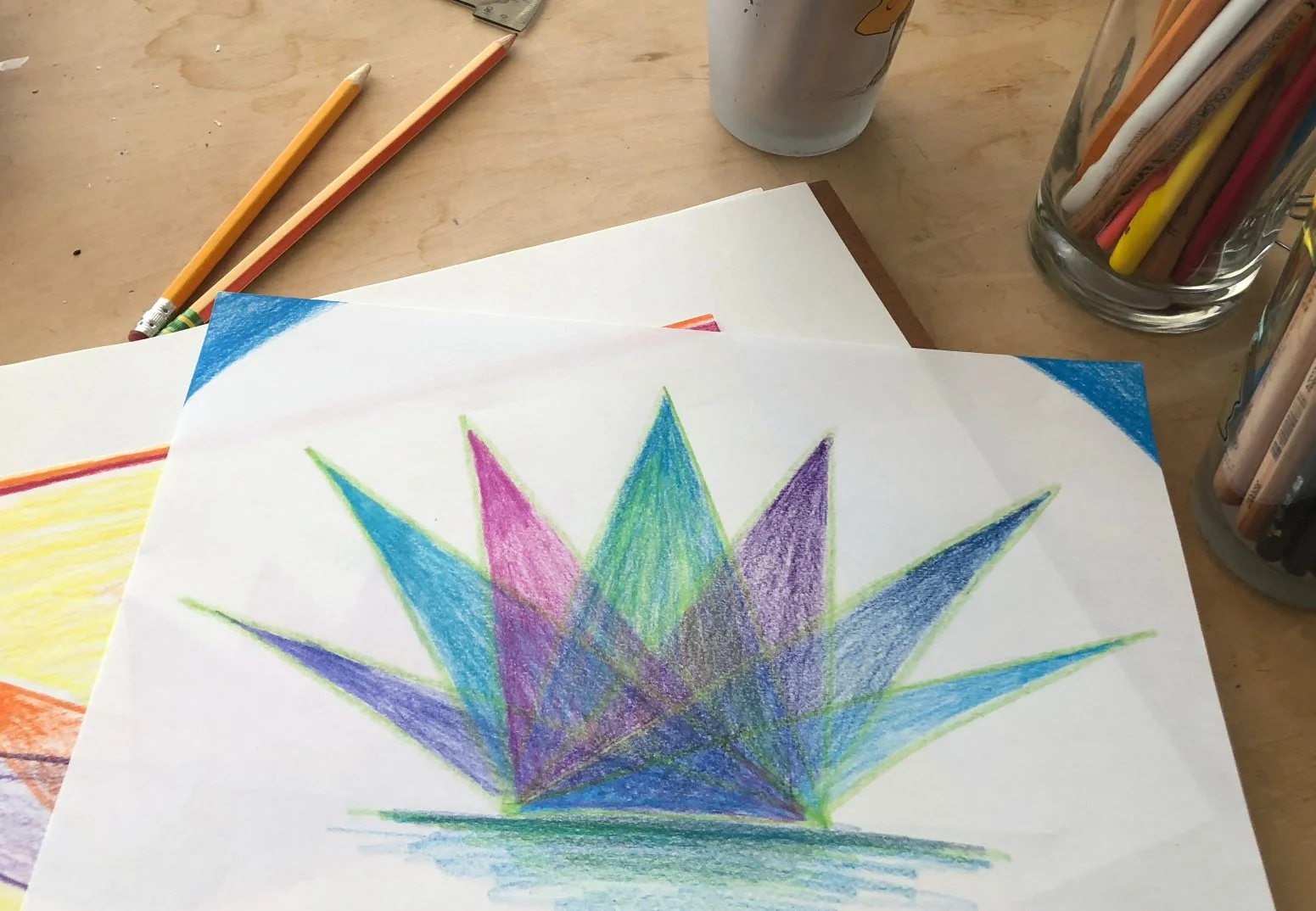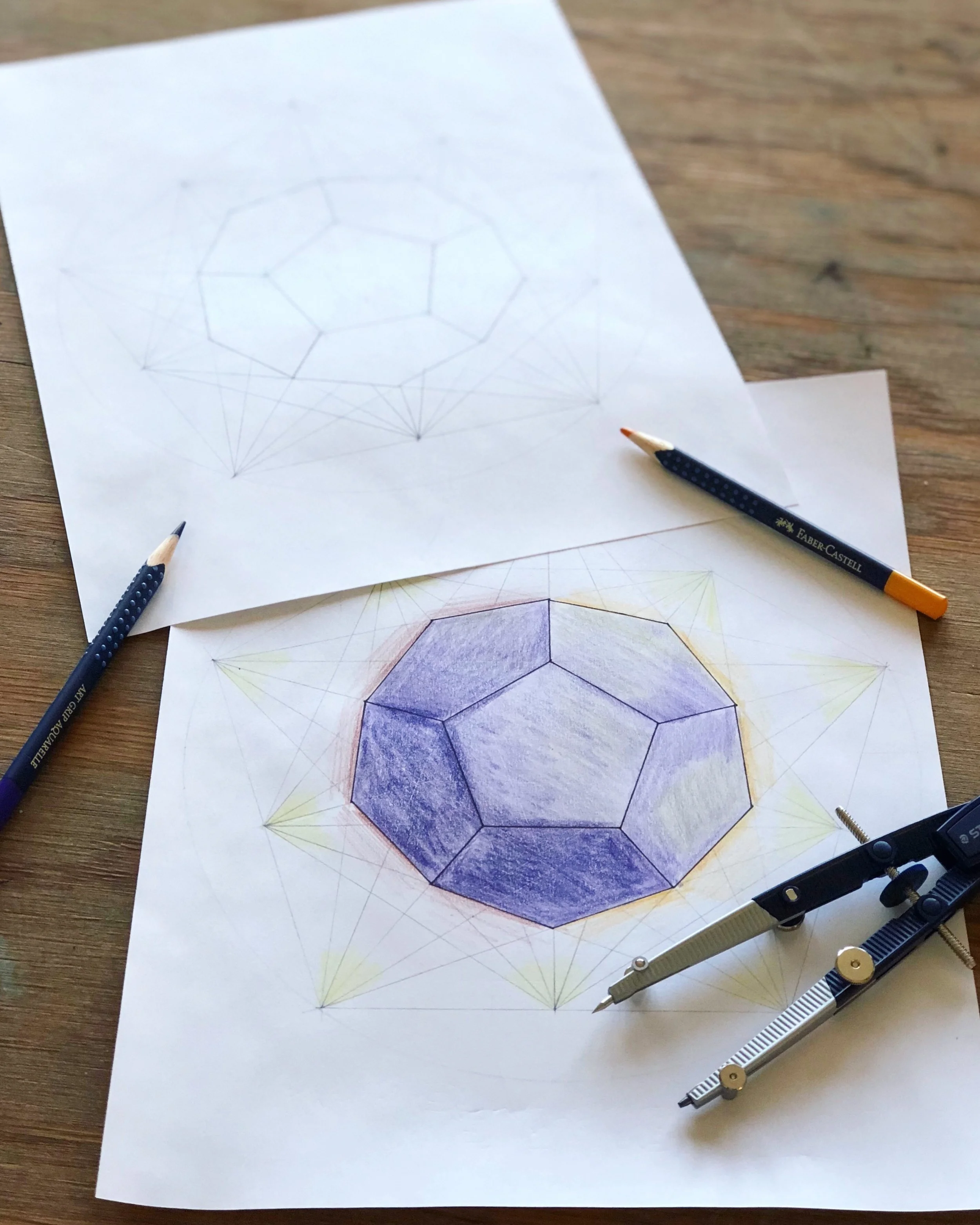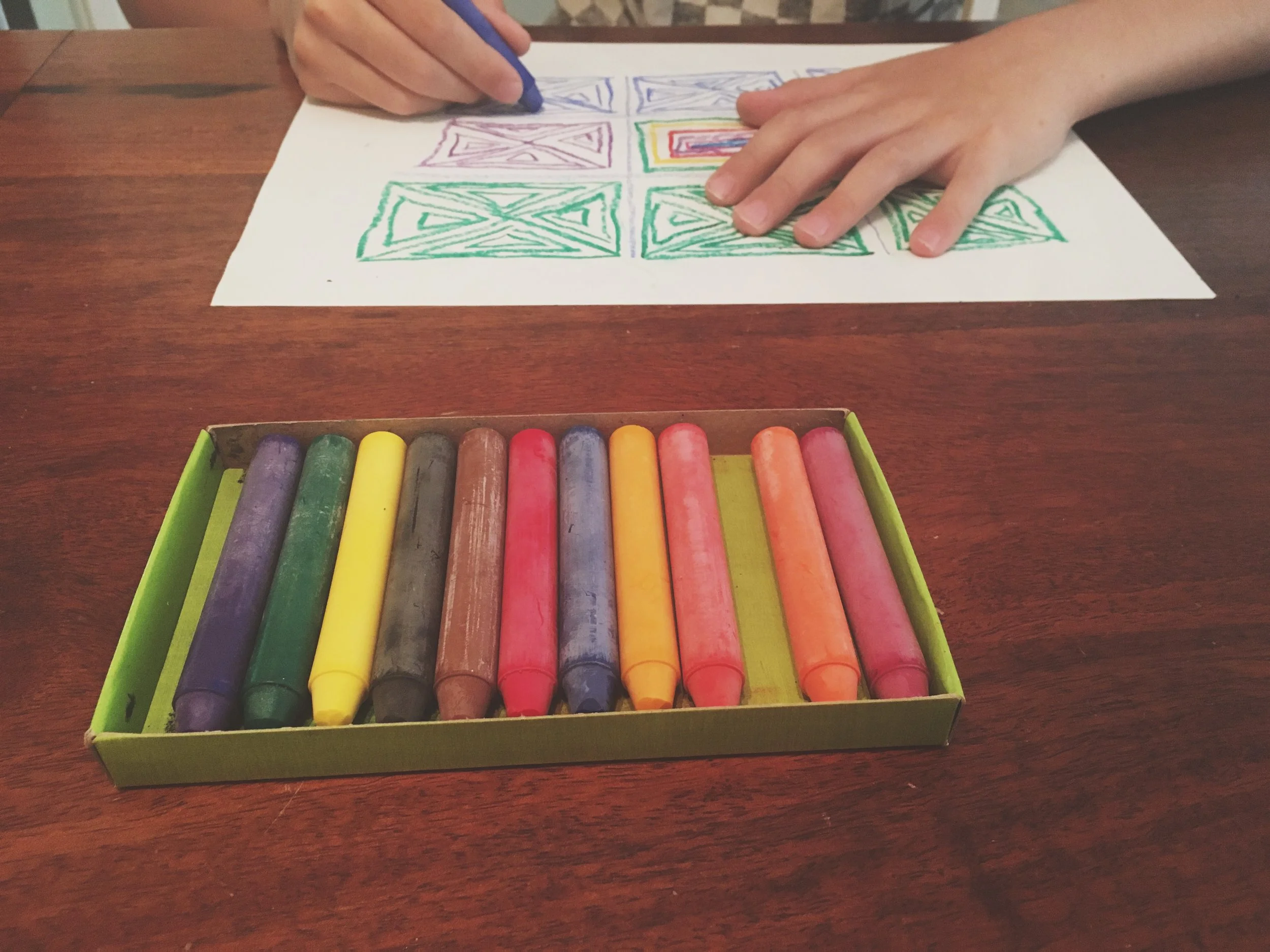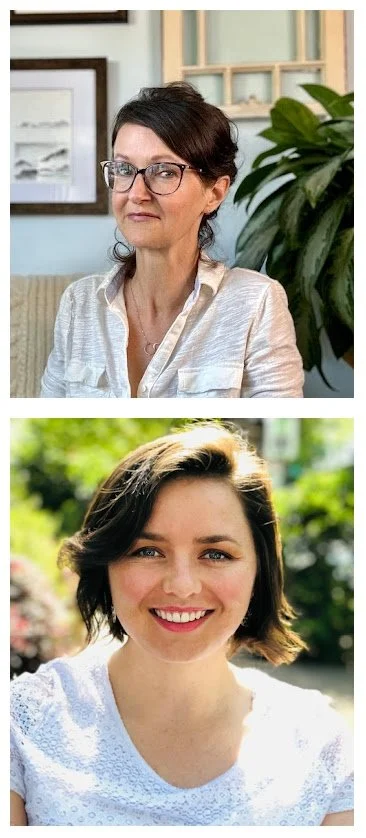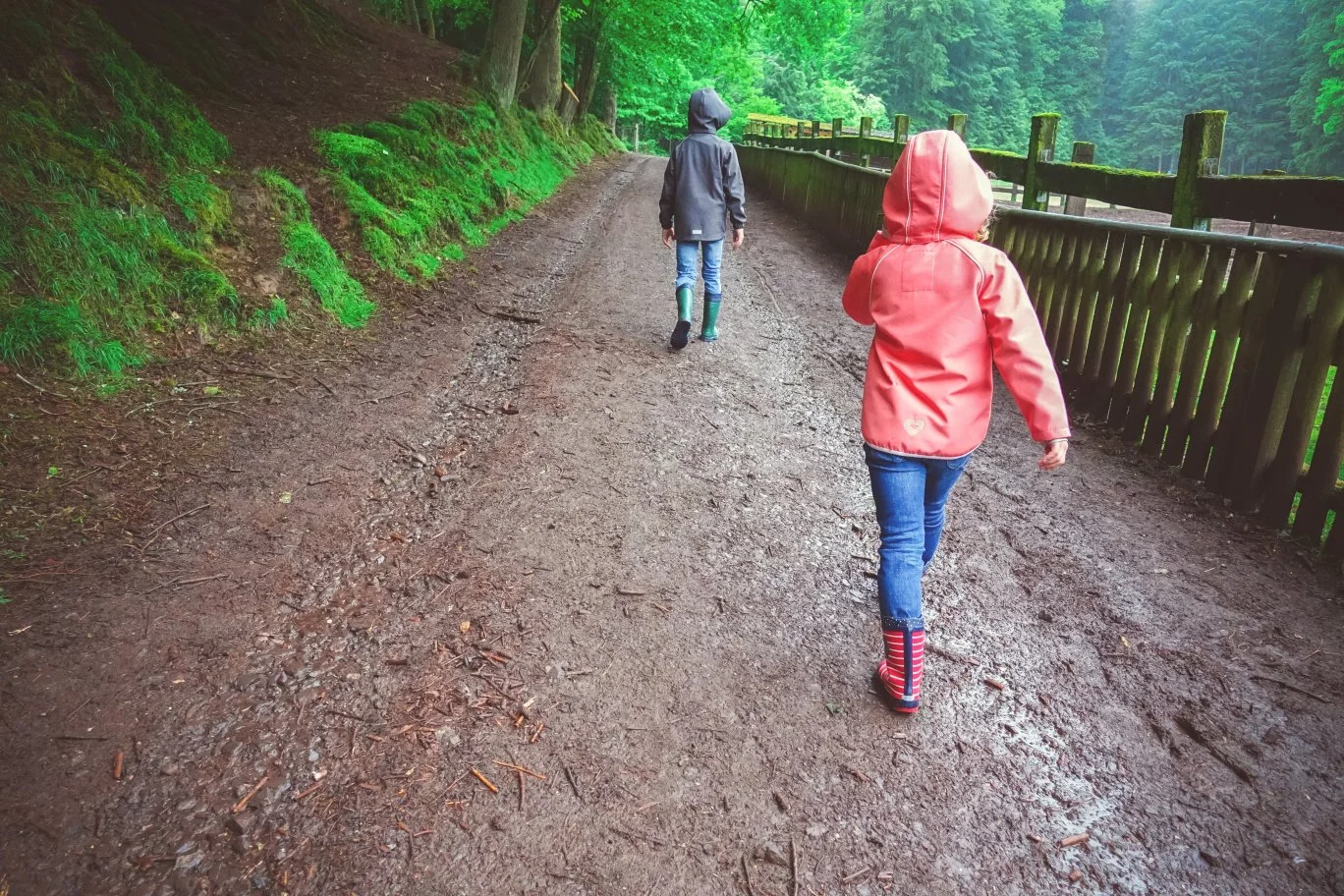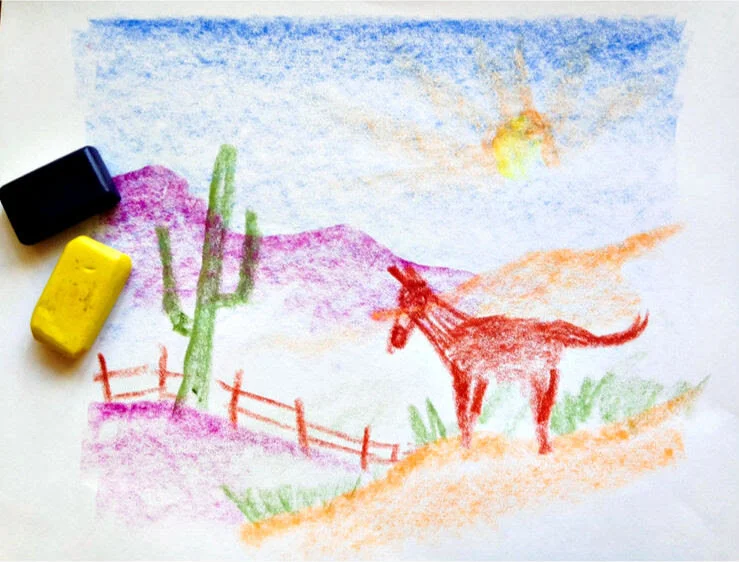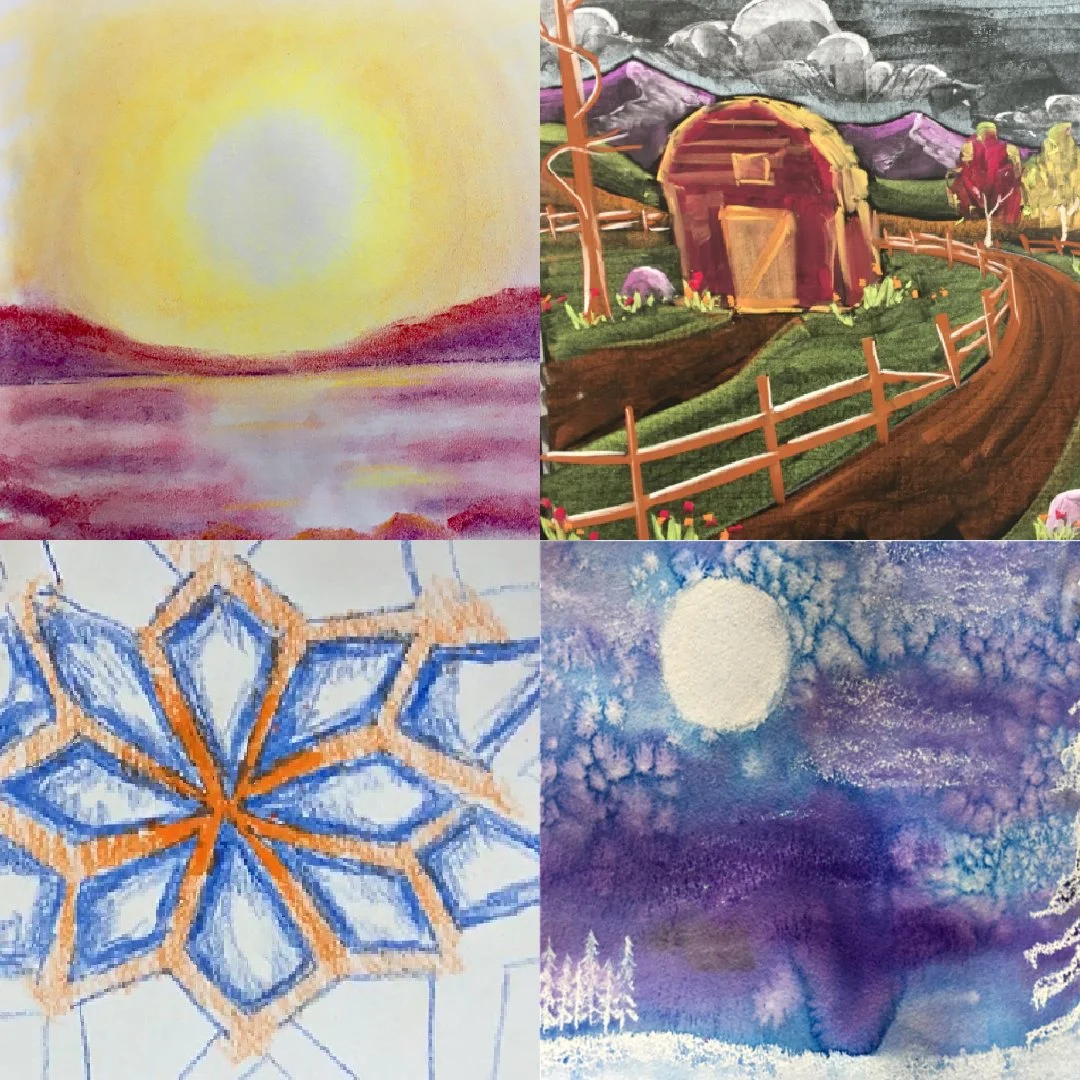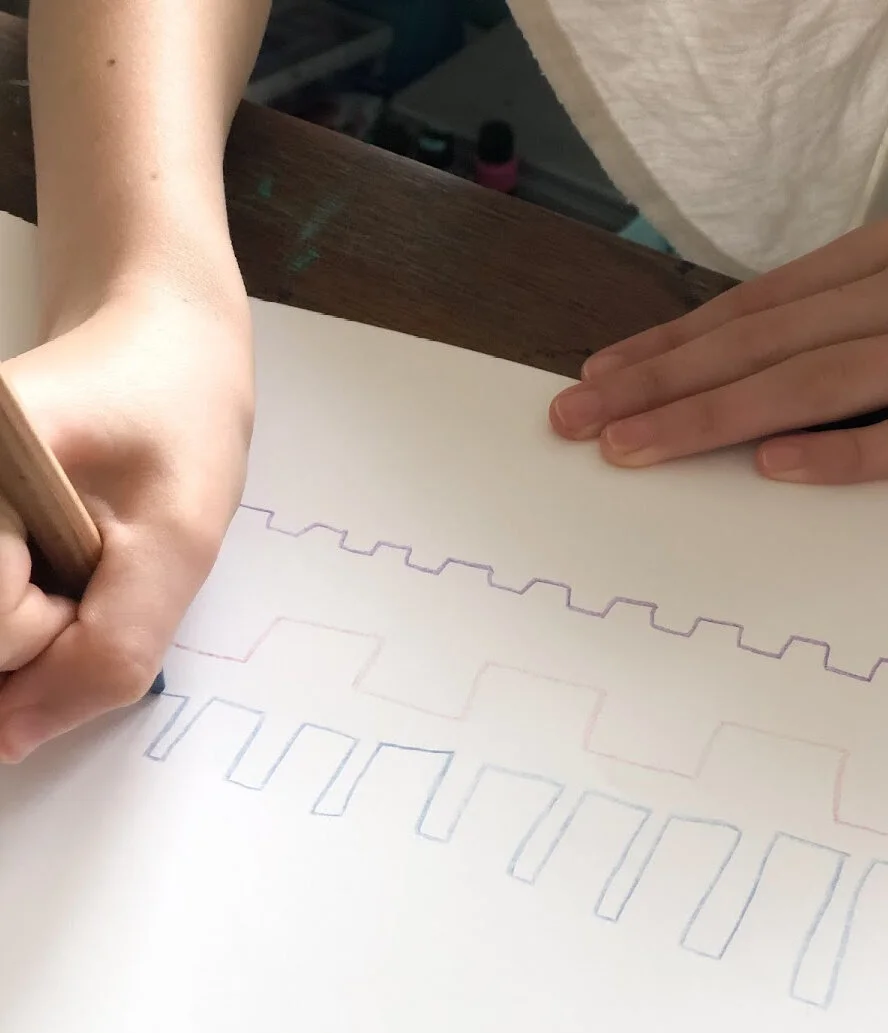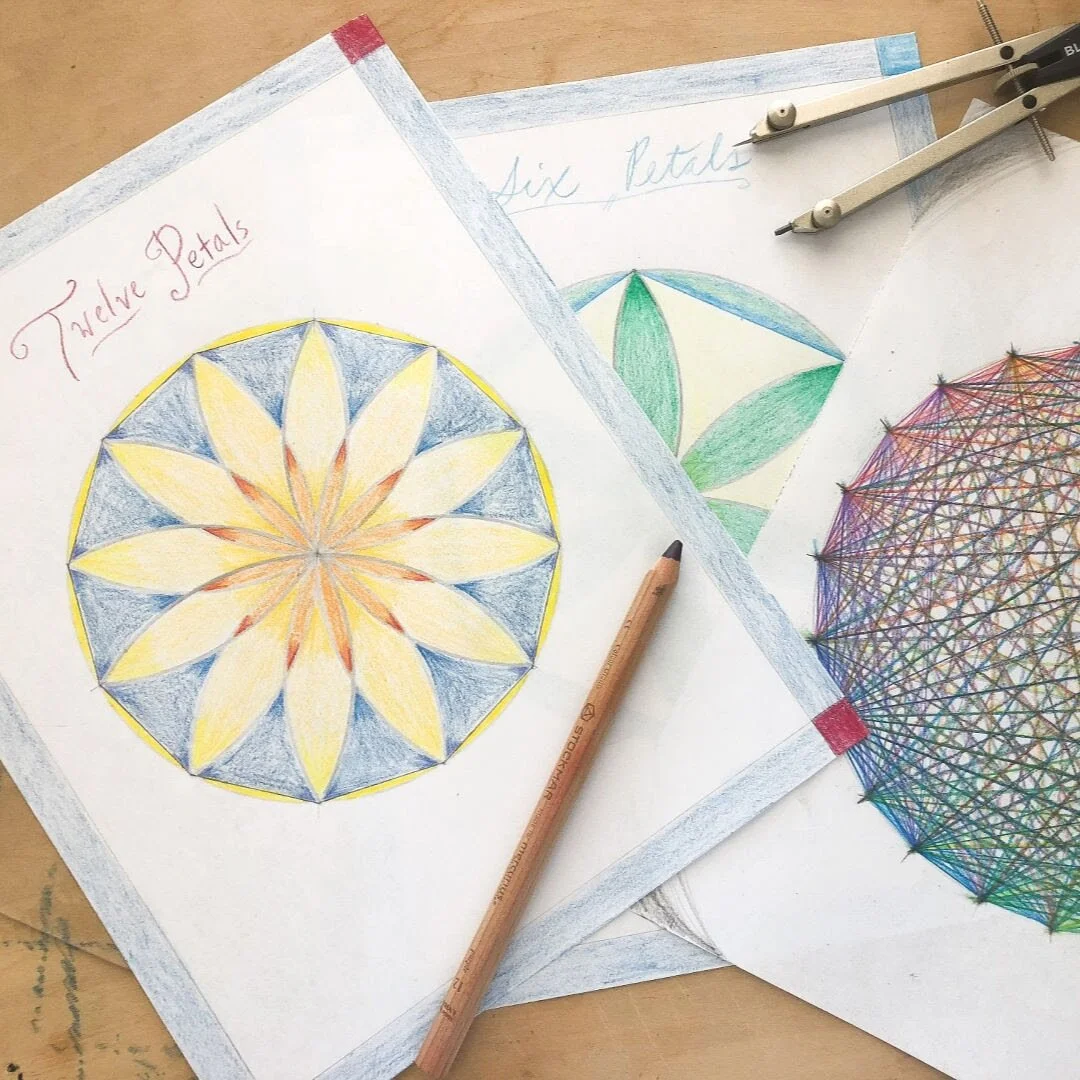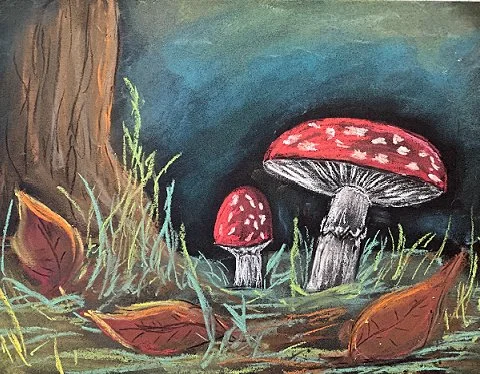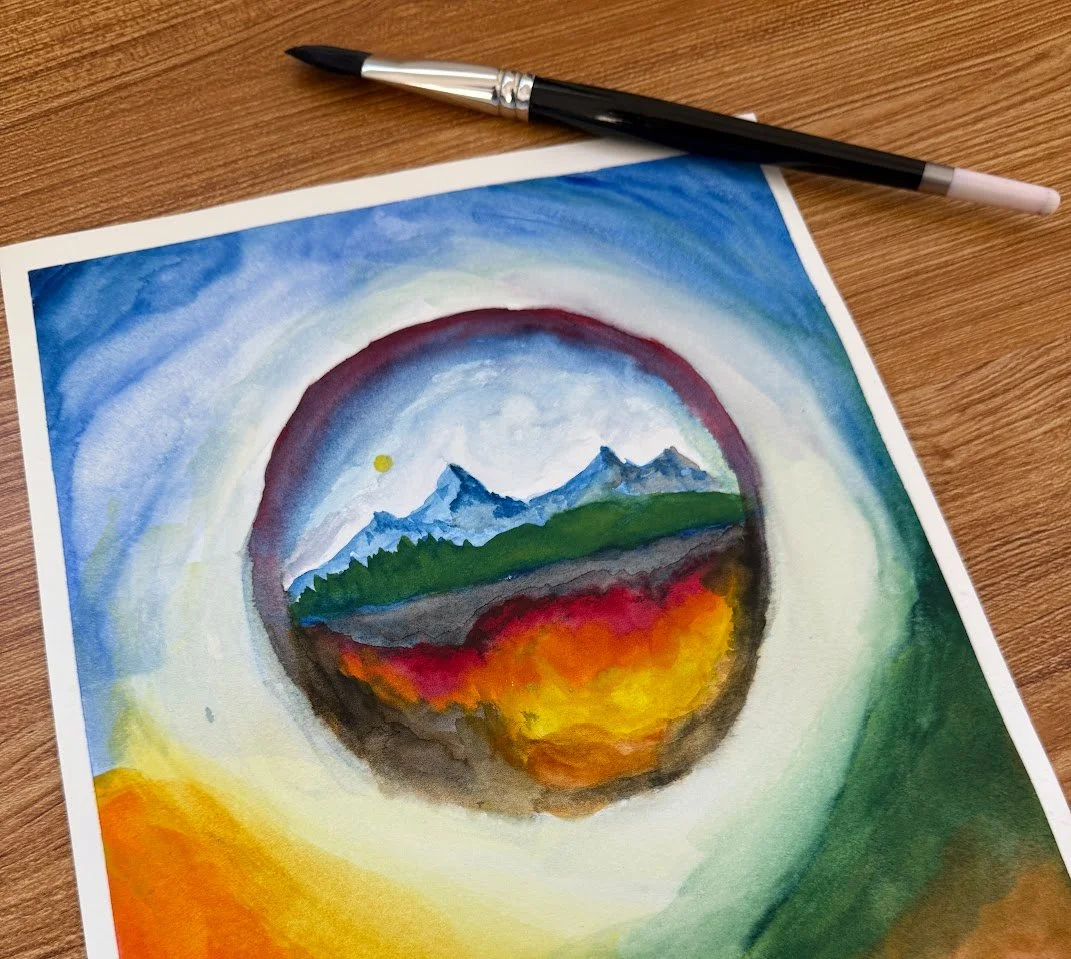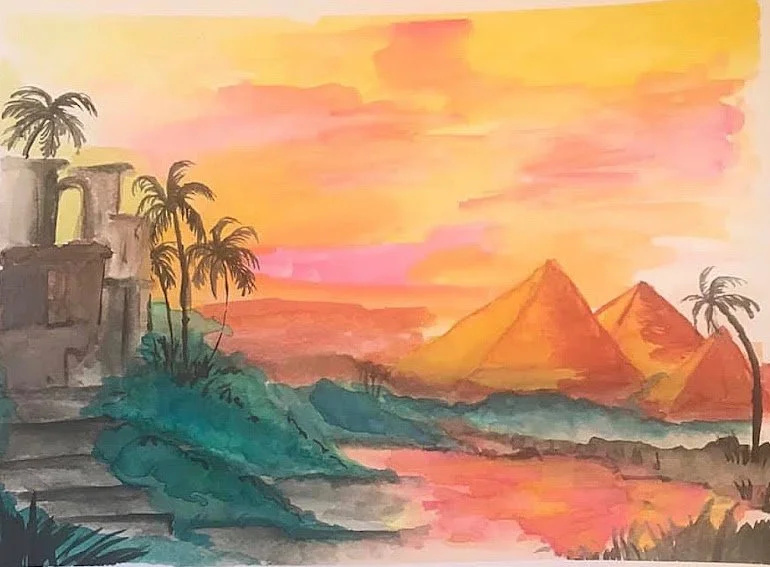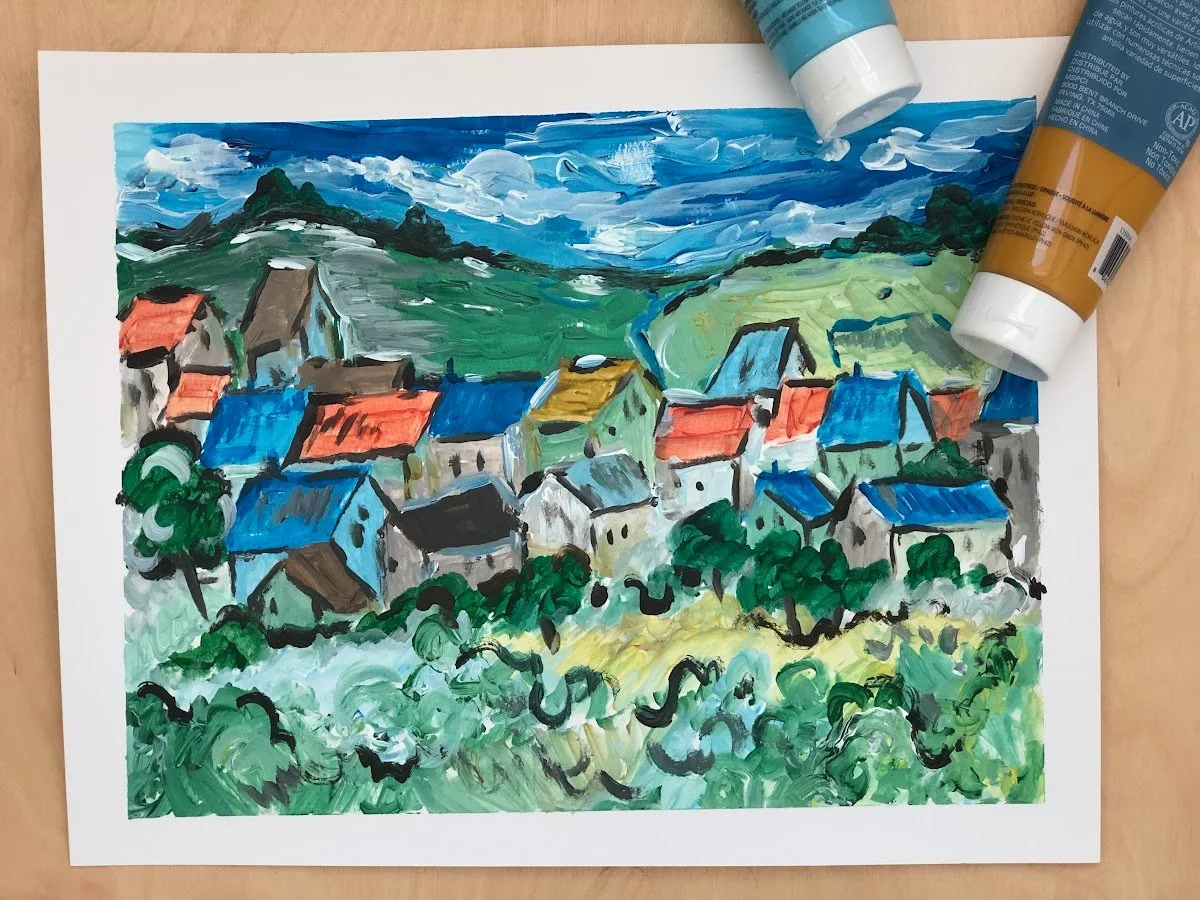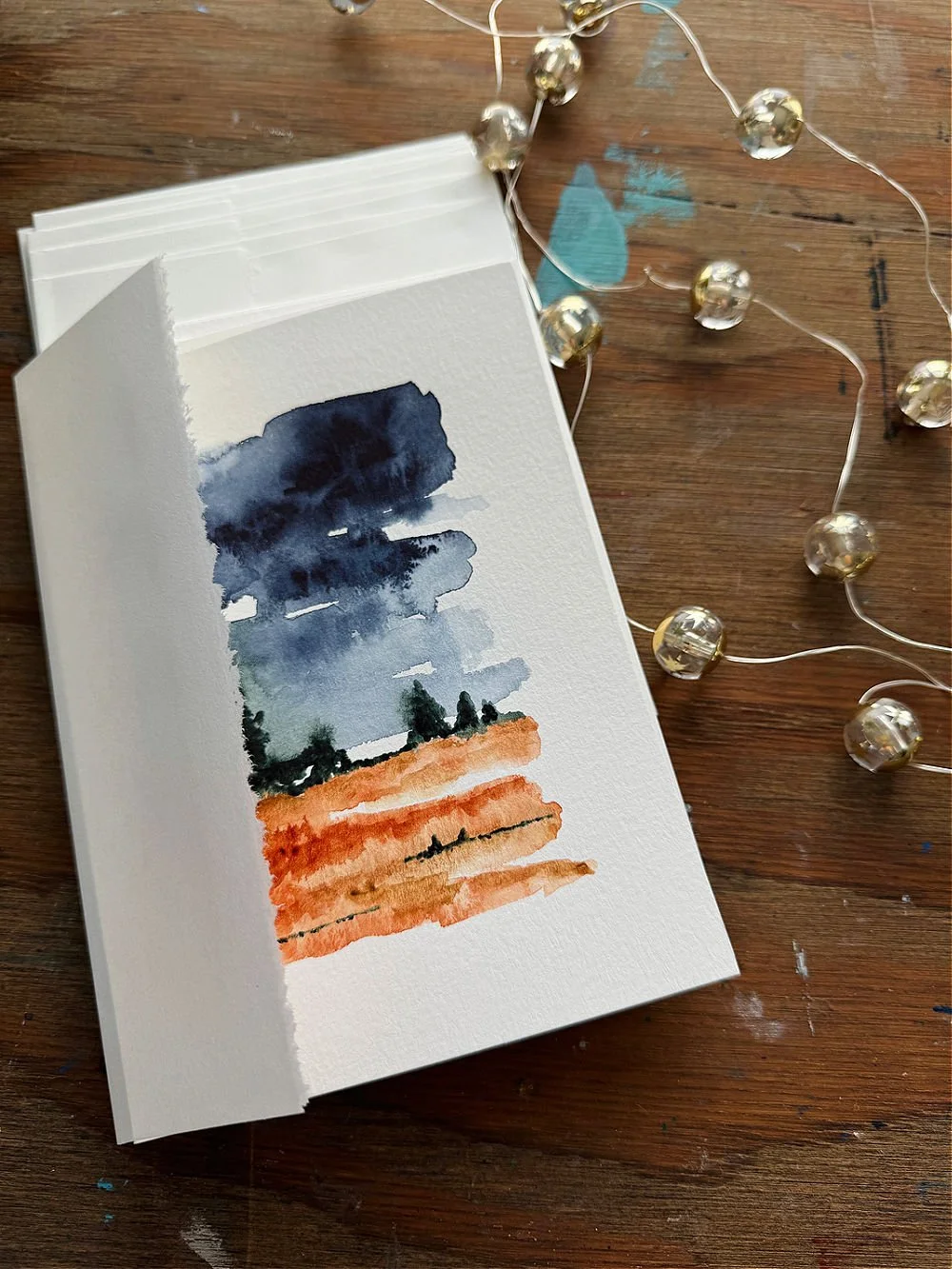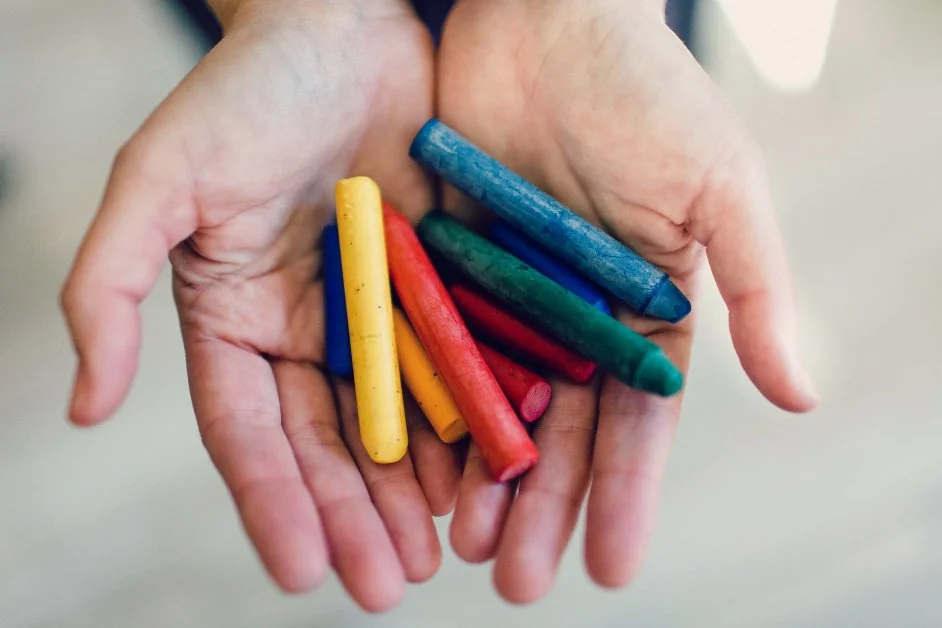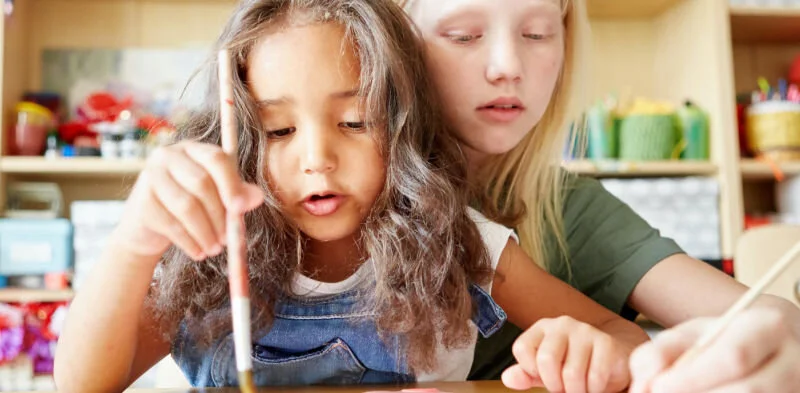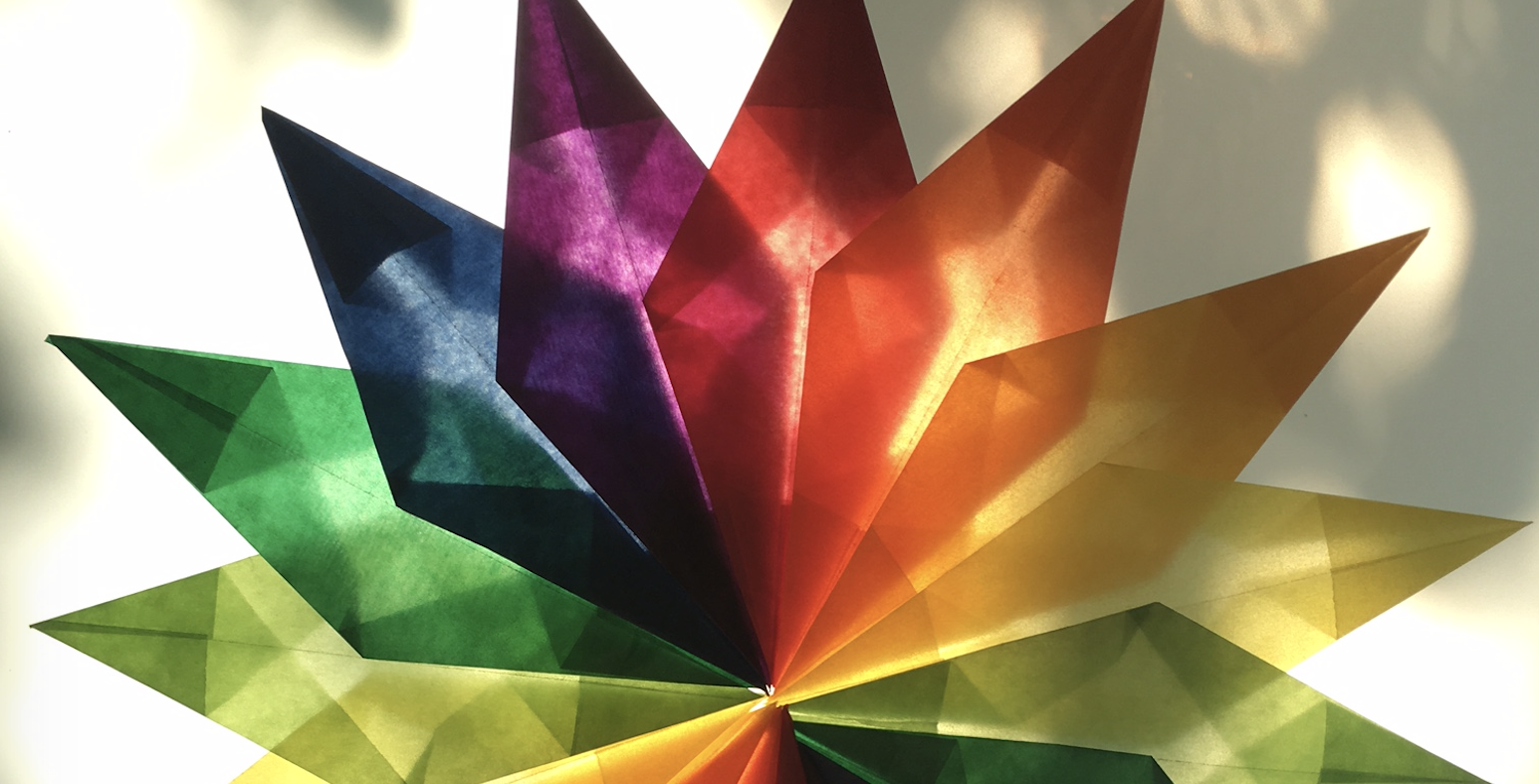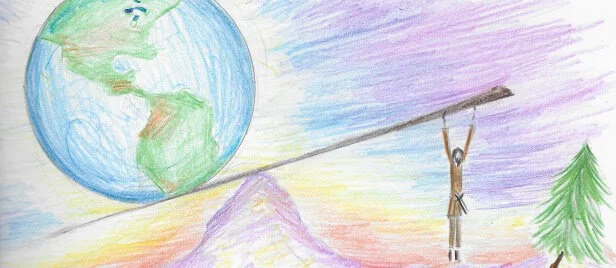
Waldorfish Blog
Waldorf Form Drawing: My child wants to turn all their form drawings into pictures - is this ok?
Waldorf form drawing is a subject that requires regular practice. This can mean drawing on a chalkboard, on the sidewalk, in sand, or on paper!
Form drawing can be an inspirations for all kinds of creative illustrations!
The activity of drawing forms generates a portfolio of practice and more finished forms, from running forms in first grade, all the way up to woven forms in fourth grade.
As the educator presents these forms through imagination and stories, children tend to see forms as great potential for drawings and unique artwork. The running form could be a slithering snake; mirror forms are a butterfly in progress; the vertical line form is an unfinished fence for sheep. The possibilities for drawings made from form drawings are endless!
Should children take their forms and turn them into drawings? Is it part of the form drawing experience? These are great questions to consider!
The short answer: yes, it is perfectly fine for a child to turn their form drawings into unique and artistic pictures, however, this activity is separate from what form drawing brings to a child’s development and educational experience.
Form drawing and drawing pictures from forms are two separate processes, and it is important for the educator to keep them independent of each other.
Be sure to keep the form drawing practice as a stand-alone activity.
Take the time to fully introduce the form through story or image. Practice forms in a rhythmical, regular way, and remember that practice is by far the most important process of the form drawing. Hold the thread of the intentional practice to the end, so that the child can fully experience the form and all that it is meant to bring to their developmental growth.
When that process is fully complete, and the particular form has been put to rest, it is then a wonderful activity to take the forms and use them as the foundations to imaginative artwork.
Practice, enjoy, and create!
About the Authors
Robyn Beaufoy is Waldorfish’s CEO, and also a course instructor for Simple Season (coming soon!), Waldorf Art for Beginners, and Weekly Art Foundations. You’ll find her intuitive touches and influences throughout everything Waldorfish offers! Robyn has been in the world of education for over 25 years, with an MA in Education and a certification in Waldorf teaching - she also homeschooled both of her children for some of that time. In 2012 Robyn co-founded Waldorfish.com, creating it with the vision of making Waldorf inspired-art and pedagogy more accessible, joyful, and doable for homeschoolers all over the world.
Caitlin Amajor is Waldorfish’s course instructor for Geometry grades 5 & 6, and Botany, as well as our Administrative Assistant. From a young age, Caitlin has been immersed in Waldorf education, attending a Waldorf school from K-8. After receiving a BA in History, Caitlin gained her certification in Waldorf teaching, and spent seven years as a Waldorf class teacher in the upper grades. With a special fondness for watercolor painting and geometry, Caitlin loves bringing Waldorf education to her students all over the world, and seeing their own individuality and style bloom from the curriculum!
Waldorf 5th Grade Geometry Curriculum: Building a Strong Foundation
A freehand geometric form of growing circles.
In Waldorf curriculum, fifth grade marks the beginning of geometry studies.
Thus far, students have built their understanding of forms through Form Drawing lessons and their abilities in spatial awareness, pencil grip, balance and symmetry have grown through those experiences.
In fifth grade, it's time to jump into Geometry, and begin exploring its foundations!
The fifth grade child is in a particularly special time in childhood, often referred to as the “golden age.” Physically, they are balanced and graceful; stronger and more sure in their movements than that of a young child, and without the awkwardness that often marks the physicality of a teenager.
Inwardly, they are uniquely in-between the magic of early childhood and the realism of middle school. They are discovering a newfound curiosity and desire to understand how the world works in the present and what has happened in the past – all while finding beauty and magic in every aspect.
Finding beauty in truth- the fifth grader is ready to explore geometry!
Fifth grade geometry curriculum is rich, challenging, and fun!
Geometry is everywhere, and one aspect of the fifth grade curriculum is finding geometry in nature, history, and all around us! The pyramids of ancient Egypt, the columns of ancient Greece, petals on blooming plants in Botany, exploring the patterns of music: geometry fits into all these subjects in various ways. Fifth graders have a fascination for the world around them, and finding geometry in different and unexpected places cultivates an appreciation and sense of wonder for the subject.
With geometry comes a whole new set of vocabulary and meanings, and it is important that the fifth grader explores these in a way that feels alive and engaging.
Instead of simply memorizing terms and definitions, vocabulary can be explored through movement and hands-on experiences to forge connections. For example, instead of discussing what “circumference” means, a fifth grader may walk the circumference of a large circle drawn with chalk. A “diameter” and “radius” can be created with popsicle sticks; quadrilaterals can be compared through a dramatic skit about the evolution of angles and sides. The fifth grader gains true understanding of vocabulary through doing, exploring, and connecting.
Drawing freehand is a key aspect of the fifth grade curriculum- no tools just yet, as those will be introduced in sixth grade. The fifth grader is experiencing a balance and symmetry in their own physical bodies and inner life that will soon change through puberty, so it is a truly perfect time to cultivate their relationship with geometry without leaning on anything other than their own skills and abilities.
Drawing freehand is all about practice and improvement- not perfection!
With finding geometry in nature and experiencing its language through doing, the fifth grader dives into drawing forms. Variations of triangles, circles, and quadrilaterals are drawn throughout many practice sessions, all culminating in a “final form” which is beautifully shaded and created with care and effort.
In a practical sense, the practice of drawing builds their capacities in creating geometric forms that are accurate and balanced. As well, drawing freehand connects the child with geometry on a deep soul level, because they have experienced it in a direct and organic way.
Geometry curriculum evolves with the growing child as they progress through middle school and beyond. The sixth grader will learn to use tools, the seventh grader finds patterns and sequences, and the eighth grader shifts their thinking into the abstract and 3D world.
But to move forward into the upper grades and the ever more complex world of geometry, the student needs a strong and true foundation that is cultivated through the fifth grade curriculum.
Are you looking to bring freehand geometry into your homeschool classroom? We can help!
Click here to learn more about our course that provides a full year’s worth of geometry curriculum for the growing fifth grader.
About the Authors
Robyn Beaufoy is Waldorfish’s CEO, and also a course instructor for Simple Season (coming soon!), Waldorf Art for Beginners, and Weekly Art Foundations. You’ll find her intuitive touches and influences throughout everything Waldorfish offers. Robyn has been in the world of education for over 25 years, with an MA in Education and a certification in Waldorf teaching - she also homeschooled both of her children for some of that time. In 2012 Robyn co-founded Waldorfish.com, creating it with the vision of making Waldorf inspired-art and pedagogy more accessible, joyful, and doable for homeschoolers all over the world.
Caitlin Amajor is Waldorfish’s course instructor for Geometry grades 5 & 6, and Botany, as well as our Administrative Assistant. From a young age, Caitlin has been immersed in Waldorf education, attending a Waldorf school from K-8. After receiving a BA in History, Caitlin gained her certification in Waldorf teaching, and spent seven years as a Waldorf class teacher in the upper grades. With a special fondness for watercolor painting and geometry, Caitlin loves bringing Waldorf education to her students all over the world, and seeing their own individuality and style bloom from the curriculum!
5 Tips for Studying the Lower Plants in Waldorf Fifth Grade Botany
Why begin with the “lower plants” in Waldorf Botany curriculum? In fifth grade Botany, we often begin with a full block that explores the “lower plants” or “simple plants”- algae, fungi, lichen, moss, and ferns.
Curious to learn more about why botany is usually split into two blocks? Click here!
Hands-on experience is the best way to connect with the lower plant world!
While we know that some of these lower plants are not all truly plants, each of these organisms have a magical, mystical sense to them in their structures, purpose, and appearance. Exploring them opens up the world of botany for the student in a gentle way; perfect for the young fifth grader who is just beginning their developmental journey towards puberty and middle school.
How can you bring hands-on experiences of the lower plants into your botany curriculum?
We’ve got five ideas to get you started!
Algae
Plan a time to be out in nature, and see if you kind find algae in a nearby river, lake, or beach. Note its color, movement, texture, and location. Not near a body of water? Head to your local library and ask for books and resources on algae, preferably one with all kinds of images!
Lichen
Head outside and try to find lichen. Look around on surfaces: fence posts, rocks, concrete, stepping stones, etc. This is a great activity even for those who live in urban areas- you’ll be surprised where lichen grows!
Fungi
Create your own sourdough starter (a yeast fungi!) and learn how to tend to it to make it active for baking. Make bread, pancakes, bagels- the sourdough possibilities are endless!
Moss
Build a terrarium using moss, plants, and other elements. This can be used as an ongoing project throughout your study of Botany, as you can continuously add to your terrarium, and watch it thrive!
Ferns
Bring ferns into the kitchen! Head to your local market and purchase some fiddleheads for a taste test. After observing them closely, find a yummy recipe and cook them up together.
Enjoy the outdoors, and see what you discover!
When it doubt- Go outside! You’ll be amazed at how the lower plants thrive in even the most unexpected places. Explore and connect with nature- it’s always worth it!
Looking for more support for the fifth grade Botany curriculum? Our course offers a full year’s worth of material, main lesson book page tutorials, art lessons, instructor support, and so much more!
About the Authors
Robyn Beaufoy is Waldorfish’s CEO, and also a course instructor for Simple Season (coming soon!), Waldorf Art for Beginners, and Weekly Art Foundations. You’ll find her intuitive touches and influences throughout everything Waldorfish offers. Robyn has been in the world of education for over 25 years, with an MA in Education and a certification in Waldorf teaching - she also homeschooled both of her children for some of that time. In 2012 Robyn co-founded Waldorfish.com, creating it with the vision of making Waldorf inspired-art and pedagogy more accessible, joyful, and doable for homeschoolers all over the world.
Caitlin Amajor is Waldorfish’s course instructor for Geometry grades 5 & 6, and Botany, as well as our Administrative Assistant. From a young age, Caitlin has been immersed in Waldorf education, attending a Waldorf school from K-8. After receiving a BA in History, Caitlin gained her certification in Waldorf teaching, and spent seven years as a Waldorf class teacher in the upper grades. With a special fondness for watercolor painting and geometry, Caitlin loves bringing Waldorf education to her students all over the world, and seeing their own individuality and style bloom from the curriculum!
Award-winning, art-infused, secular homeschool curriculum.
A brand new school year is around the corner; we can’t wait to support you!
Very likely, you are dreaming up your plans for the upcoming school year. Good news: we can help! We have a range of courses that are open for enrollment. All our lessons are pre-recorded, which allows you to fit them into your ideal family rhythm.
Additionally, when you buy one of our courses, you have access to all of the lessons for the lifetime of the course - no hurry to finish them in a set period of time!
Our curriculum includes instruction and support from our trained Waldorf teachers, lessons planned out for you for the entire block, supplemental activity suggestions, and detailed supply lists w/ helpful links.
One of our primary goals is to make things simpler for you, so you can focus on all the other moving pieces that this school year is sure to bring.
*Click on the links and images below to learn more about specific courses and what they each offer.
Appropriate for Ages 7 and Up:
Waldorf Art for Beginners
A great place for those who are just getting started! This eight lesson course gives the rundown on watercolor painting, beeswax crayon drawing, and chalk drawing. Everything you need in one tidy spot! Perfect for those who are brand new to Waldorf-inspired art and don’t want to spend hours on the internet finding allll the information.
Open for enrollment year-round.
A beautiful pastel drawing from our Weekly Art Foundations course!
Weekly Art Foundations
One of our most popular courses! You’ll get over 33 lessons; one delivered each week- enough for an entire school year! Access them whenever it works for your schedule. You’ll learn how to work with crayon, charcoal, wet-on-wet painting, and other common Waldorf art mediums and techniques. Plus, enjoy instructor support, guidance on working through ‘comparison syndrome,’ and so much more!
Open for enrollment twice a year. Enrollment is open NOW until August 31st, 2024
Art Lesson Bundles
Looking for art lessons, but not quite ready for a full course? Start here! Our Art Bundles include four lessons each, and provide a chance to gain experience in various Waldorf art mediums, such as chalk drawing, watercolor painting, and crayon work!
Open for enrollment year-round.
For the Lower Grades Child (Grades 1-4)
Watercolor Painting for Grades 1, 2 and 3
Created to meet the developing young child’s growth through experience in color, form, and story! Each course provides a full year’s worth of lessons, and include original verses, instructor support and insight, curriculum connections, and more!
Open for enrollment year-round.
Form Drawing for Grades 1 - 4
We offer four courses that encompass a year’s worth of form drawing curriculum for grades 1-4! With over 30 videos per course, step-by-step tutorials, and instructor support, you’ll have everything you need to bring form drawing to your child’s educational rhythm.
Open for enrollment year-round.
For the Upper Grades (Grades 5-8)
Geometry for Grades 5-8
Our four courses for grades 5-8 provide a full year’s worth of geometry curriculum instantly! With each course providing 15 lessons, each is perfect for the Waldorf homeschooling classroom, or for those using other educational methods, is also a perfect artistic supplement!
Open for enrollment year-round.
Botany
Designed for the growing fifth grader, this course provides over videos that cover a full year’s worth of curriculum. With art lessons, step-by-step guides for main lesson book pages, hands-on demonstrations, and so much more, this course provides everything your student needs to explore the vast world of plants.
Open for enrollment year-round.
Waldorf Science: Physics (Grades 6-8) and Chemistry (Grades 7 & 8)
Waldorf science curriculum for homeschool & classroom educators! Built for the educator, each course provides step-by-step demonstrations, how and why to create rhythm in the lessons, and an in-depth exploration into Waldorf teaching methods. Each course provides a full year’s worth of curriculum, detailed supply lists, instructor support, and so much more!
Open for enrollment year-round.
Geology
Designed for the sixth grader, our Geology course provides everything you need for a deep-dive into the study of the Earth. You will be provided with over 75 pre-recorded videos that cover a year’s worth of geologic exploration & lessons for your child, main lesson book page tutorials, art lessons, and so much more! Plus, the course includes a fully mapped-out research project; an opportunity to apply what they’ve learned in a hands-on way through writing, interviewing, illustrating, and presenting.
Open for enrollment year-round.
Weekly Art Diving Deeper
For students who have completed our Weekly Art Foundations course (see above), this course is built for those who are ready to enhance their artistic skills. This course includes in-depth instruction in Perspective Drawing, Figure & Portrait Drawing, charcoal, chalk drawing, watercolor and so much more!
Open for enrollment year-round.
Weekly Art…and Beyond!
Weekly Art…and Beyond is the next step in our Weekly Art series - for those who have completed our Weekly Art Diving Deeper course, and/or for high schoolers ready to stretch their artistic skills! With over 30 lessons, this course explores familiar skills such as chalk and charcoal drawing, and introduces brand new mediums such as ink work, acrylic painting, and so much more!
Open for enrollment year-round.
For Adults
Simple Season
Designed for caretakers, this course provides an opportunity to create, plan, and reflect! With three watercolor painting lessons, a simple (yet impactful!) guiding PDF, and thought-provoking discussion prompts, this mini-course will help you find what’s really meaningful to you around celebrations and holidays.
Open for enrollment through December 2024.
We’d love to teach for you this year!
Questions? Let us know how we can help —> Click here!
Looking for something?
Welcome to Waldorfish! We started this adventure in 2012 out of a desire to make Waldorf training more accessible to class teachers in remote locations and to homeschooling families everywhere! Read more, click here.
WE WON! Our Weekly Art courses were voted “best interactive art program.” Learn more about the award, here.
A few of our most popular blog posts:
